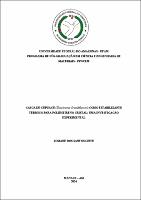| ???jsp.display-item.social.title??? |


|
Please use this identifier to cite or link to this item:
https://tede.ufam.edu.br/handle/tede/10355| ???metadata.dc.type???: | Dissertação |
| Title: | Casca de cupuaçu (Theobroma Grandiflorum) como estabilizante térmico para poliestireno cristal: uma investigação experimental |
| ???metadata.dc.creator???: | Leite, Josiane dos Santos  |
| ???metadata.dc.contributor.advisor1???: | Giacon, Virginia Mansanares |
| First advisor-co: | Mendonça, Rannier Marques |
| ???metadata.dc.contributor.referee1???: | Reinaldo, Juciklecia da Silva |
| ???metadata.dc.contributor.referee2???: | Concha, Viktor Oswaldo Cárdenas |
| ???metadata.dc.description.resumo???: | A Região Amazônia apresenta uma grande diversidade de biomassas lignocelulósicas que podem ser reaproveitadas como carga vegetal para polímeros, a fim de aprimorar suas propriedades. Nesse sentido, pode-se citar a casca do cupuaçu (Theobroma grandiflorum), um resíduo agroindustrial que já apresentou potencial como estabilizante térmico, devido ao seu caráter antioxidante. Com isso, o presente trabalho utilizou esse resíduo como carga vegetal no poliestireno cristal, visando avaliar a influência dessa incorporação nas propriedades no polímero. A caracterização química dos resíduos foi realizada através do FTIR e FRX. Além disso, o percentual mássico dos componentes majoritários do resíduo (tais como celulose, lignina, extrativos) foi determinado, bem como a atividade antioxidante e a quantidade de fenólicos totais. O comportamento térmico foi investigado por TG/DSC. A morfologia da superfície foi observada via MEV. A distribuição do tamanho de partícula foi avaliada via espalhamento a laser. O polímero foi processado em estado puro e contendo a carga vegetal por extrusão e injeção. O resíduo foi incorporado na matriz polimérica em diferentes concentrações (1, 2 e 3%). Além disso, os injetados foram submetidos ao envelhecimento térmico por estufa (nos intervalos de 15, 30, 45 e 60 dias), a fim de avaliar a influência do resíduo na degradação termo-oxidativa sofrida pelas amostras com o ensaio. Os injetados contendo polímero puro e polímero com resíduo foram caracterizados mecanicamente (ensaio de tração), termicamente (TG/DSC) e quimicamente (FTIR). Além disso, a região de fratura dos injetados foi avaliada via MEV. Os resíduos apresentaram alto teor de lignina e considerável teor de celulose, bem como boa atividade antioxidante. Os resultados para a caracterização dos injetados demonstraram que a incorporação do aditivo exerceu influência no comportamento mecânico do polímero. Além disso, a estabilidade térmica aumentou com a presença do aditivo. A região de fratura dos injetados contendo a carga aditiva apresentou dispersão homogênea da partícula na massa do polímero. Conforme o envelhecimento térmico, apenas os injetados contendo polímero puro apresentaram desempenho inferior nas propriedades mecânicas e térmicas, além disso, os injetados puros exibiram região de fratura mais danificada em comparação aos demais, o que implica que a presença do aditivo pode ter interferido nos processos degradativos ocorridos. |
| Abstract: | The Amazon Region offers a high diversity of lignocellulosic biomasses that can be reused as vegetal fillers for polymers, in order to improve their properties. In this context, we can mention cupuaçu husk (Theobroma grandiflorum), an agro-industrial residue that has already shown potential as a thermal stabilizer, due to its antioxidant properties. Therefore, the present work used this residue as a vegetal filler in crystal polystyrene to evaluate the influence of its incorporation on the polymer’s properties. The chemical characterization of the residue was performed using FTIR and FRX. Furthermore, the mass percentages of its major constituents (such as cellulose, lignin and extractives) were determined, as well as its antioxidant activity and total phenolics content. The thermal behavior was investigated by TG/DSC. The surface morphology was observed by SEM. Particle size distribution was evaluated by Laser Light Scattering (LLS). The polymer was processed in its pure form and with vegetal filler through extrusion and injection. The residue was incorporated into the polymeric matrix at different mass proportions (1%, 2% and 3%). Additionally, samples were submitted to thermal aging in a oven (with durations ranging from 15, 30, 45 to 60 days), to evaluate the influence of the additive incorporation on the thermo-oxidative degradation of the polymer during the test. The samples were characterized mechanically (tensile test), thermally (TGA/DSC), and chemically (FTIR). Furthermore, the fracture regions of the samples were evaluated by SEM. The residues exhibited a high lignin content and substantial cellulose content, as well as good antioxidant activity. Results demonstrated that the incorporation of the additive influenced the mechanical behavior of the polymer. Additionally, thermal stability increased with the presence of vegetal filler. The fracture region of the sample with vegetal filler showed homogeneous dispersion of the particle in the polymer matrix. According to the thermal aging, samples with only pure polymer showed lower performance in terms of mechanical and thermal properties. Moreover, the fracture region of these samples exhibited more surface damage compared to the other types of samples, implying that the presence of vegetal filler may influence the degradation process of the samples. |
| ???metadata.dc.subject.cnpq???: | ENGENHARIAS:ENGENHARIA DE MATERIAIS E METALURGICA |
| ???metadata.dc.subject.user???: | Resíduo agroindustrial Biomassa lignocelulósica Carga vegetal Estabilizante térmico |
| Language: | por |
| ???metadata.dc.publisher.country???: | Brasil |
| Publisher: | Universidade Federal do Amazonas |
| ???metadata.dc.publisher.initials???: | UFAM |
| ???metadata.dc.publisher.department???: | Faculdade de Tecnologia |
| ???metadata.dc.publisher.program???: | Programa de Pós-graduação em Ciência e Engenharia de Materiais |
| Citation: | LEITE, Josiane dos Santos. Casca de cupuaçu (Theobroma Grandiflorum) como estabilizante térmico para poliestireno cristal: uma investigação experimental. 2024. 103 f. Dissertação (Mestrado em Ciência e Engenharia de Materiais) - Universidade Federal do Amazonas, Manaus (AM), 2024. |
| ???metadata.dc.rights???: | Acesso Aberto |
| ???metadata.dc.rights.uri???: | https://creativecommons.org/licenses/by-nc-nd/4.0/ |
| URI: | https://tede.ufam.edu.br/handle/tede/10355 |
| Issue Date: | 23-Jul-2024 |
| Appears in Collections: | Mestrado em Ciência e Engenharia de Materiais |
Files in This Item:
| File | Description | Size | Format | |
|---|---|---|---|---|
| DISS_Josiane Leite_PPGCEM.pdf | 5.53 MB | Adobe PDF |  Download/Open Preview |
Items in DSpace are protected by copyright, with all rights reserved, unless otherwise indicated.




